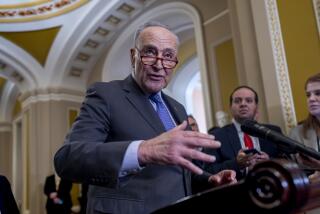B-2 Bomber, ‘Star Wars’ Survive Tests in Senate : Defense: In close votes, lawmakers reject limiting plane production to 15, cutting missile system funding.
WASHINGTON — The Bush Administration’s two prime weapons programs--the B-2 Stealth bomber and the “Star Wars” anti-missile defense system--narrowly survived Senate challenges Wednesday in the first test of congressional sentiment since the collapse of the Soviet Union.
The embattled B-2 had its closest call yet when the Senate came within only three votes of going along with a House decision to halt production at 15 planes, saving $30 billion.
Later, “Star Wars,” formally known as the Strategic Defense Initiative, survived by just one vote an attempt to slash $1.1 billion from proposed funding in the fiscal year that begins Tuesday.
After an attack on the B-2 lost handily only six weeks ago, opponents picked up substantial strength by citing dramatic events in the Soviet Union as well as test results that called into question the plane’s main virtue: its ability to evade radar.
“After more than a decade, the plane finally appears--just as the Soviet Union disappears,” Sen. Patrick J. Leahy (D-Vt.) declared scornfully during more than seven hours of intense debate.
The critics also argued that the huge federal budget deficit together with pressing domestic needs made it necessary to junk the Bush Administration’s plan to have Northrop Corp. of Los Angeles build 75 of the bat-winged bombers, priced at $865 million apiece.
“We have to look at the future of the nation in the light of a changed world. . . . Defense cannot continue to be sacrosanct,” said Sen. Robert C. Byrd (D-W. Va.), chairman of the Senate Appropriations Committee and one of six Democrats who switched sides to oppose the B-2.
B-2 proponents survived the assault by guaranteeing in a $270.4-billion defense spending bill that Congress would have another vote next spring on whether to spend $3.2 billion earmarked for four additional bombers. By then, more critical tests will have been completed.
The proponents contended that a large B-2 fleet still was needed because of continuing uncertainty about whether hard-line Soviet leaders might return to power.
The B-2 was designed primarily to retaliate against a Soviet nuclear attack, but supporters also contend that it would be effective in conventional conflicts, such as the Persian Gulf War.
“This will affect the credibility of American defenses into the next century,” Sen. Ted Stevens of Alaska, ranking Republican on the Senate defense appropriations subcommittee, said in arguing against curbing production of the revolutionary B-2.
By 51 to 48, the Senate voted to table, and thus kill, an amendment by Sen. Jim Sasser (D-Tenn.) to delete B-2 funds from the defense spending bill. Sen. Alan Cranston (D-Calif.) supported the amendment, while Sen. John Seymour (R-Calif.) opposed it.
On Aug. 1, a similar measure was defeated by 15 votes.
The outcome Wednesday could have been even closer. Sen. Bob Kerrey (D-Neb.), a B-2 opponent, was out of town exploring a run for President. Sen. Carl Levin (D-Mich.) voted for the B-2 only after getting a promise of more radar tests. And Sen. Jeff Bingaman (D-N. M.) at first voted to halt B-2 production, then switched sides after having a chat with Sen. Sam Nunn (D-Ga.), influential chairman of the Senate Armed Services Committee.
Vice President Dan Quayle made a rare appearance in the presiding officer’s chair, ready to break a tie in favor of the B-2.
The Senate later rejected, by 50 to 49, another Sasser amendment that would have cut $1.1 billion from the $4.6 billion budgeted for “Star Wars.” Cranston voted for the measure, and Seymour voted against it. A similar amendment failed Aug. 1 by six votes.
If Kerrey had been present Wednesday, his vote probably would have knotted the count at 50-50. But, once again, Quayle was on hand to break the tie in favor of higher “Star Wars” spending.
Sasser, chairman of the Senate Budget Committee, also offered an amendment to cancel procurement of a rail car to carry the MX long-range nuclear missile between hiding places. A vote on that proposal was set for today.
“Clearly, spending on the magnitude of B-2 and SDI will crowd out other strategic and domestic investments across the board . . . in roads and bridges, health, education and crime prevention, military personnel and training,” Sasser said.
Seymour, defending the job-rich B-2 as he faces a tough election campaign, called the bomber “the most flexible, accurate and survivable strategic air system ever developed.”
He noted that Bush “has made this . . . his top acquisition priority for the Air Force even though the defense budget will decrease by 25% over the next four years.”
More to Read
Get the L.A. Times Politics newsletter
Deeply reported insights into legislation, politics and policy from Sacramento, Washington and beyond. In your inbox three times per week.
You may occasionally receive promotional content from the Los Angeles Times.










